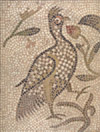
THE TYPICAL HOME IN POMPEII
While the Forum, the baths, the theatres , the amphitheatres and the inns were the centre of the Romans’ intense municipal life, the domus, i.e. the house, was looked upon as a “refuge” and the heart of the family’s private life. The town plan of Pompeii is characterized by a web of streets which cross one another to form a number of blocks called insulae. The houses were built on these insulae and the area corresponding to one insula usually comprised several independent houses, but there were also important residences such as the House of the Faun which occupied a whole block.
Generally speaking, the residential buildings in Pompeii are one-family houses with no upper floor and are completely “sealed off” from the surroundings. Their rooms are arranged in a hierarchical pattern round a central courtyard called the atrium. The house was lit through an opening on the roof of the atrium called complivium. The rainwater was collected in a pool called impluvium, positioned right under the compluvium, and from there it was made to flow into an underlying cistern where it was stored.
A narrow hallway called the fauces provided access to the house which was often flanked by a tabernae (shops) opening directly onto the street.
The atrium is an inner courtyard open to the sky. When the surrounding roof has no supporting pillars, the atrium is said to be of the Tuscan type, if it has four supporting pillars it is called a tetrastyle atrium, and if there are more than four pillars it is said to be of the Corinthian type. A number of smaller rooms, usually cubicula (bedrooms) or store-rooms, were situated on either side of the atrium.
The tablinum was usually positioned opposite the main door and was both the most important and the most “sacred” part of the house, being used both for reception purposes and as the hub of the family life. The family’s archives and the images of its forefathers were kept in the alae - two rooms positioned on either side of the atrium.
The larger houses had a back garden which could be reached through a hall-way from the atrium and was mainly used to grow vegetables to meet the needs of the family.
In the II century b.C. the average size of the house increased as a result of the influence of the Hellenistic construction techniques. In place of the vegetable garden the Romans began to build a perystile, i.e. a colonnade, and would decorate the garden with sculptures and fountains and arranged the remaining living rooms all around it.
For less pretentious houses they would occasionally depart from the classical model with the rooms all around the atrium and adopt a different plan.
The rooms were located along a longitudinal axis starting from the entrance and were arranged on either side of a rectangular room without an impluvium respectively facing the inner garden and the street. This type of house usually had an upper floor whose rooms opened onto a landing at the top of a wooden staircase.
Another type of Pompeian building is the one used simultaneously for residential and commercial purposes.
In this kind of house the ground-floor usually comprised a shop looking onto the street and a back-room and was possibly completed by one or two upper floors.
In the II century b.C., houses were built in the part of the town which commands a scenic view of the countryside as far as the sea. Some of the houses were built right upon the town walls so as to conceal the latter from the sight, while others were constructed by terracing the natural slopes of the hill on which the original core of the town had been founded.
As it is unlikely the town was ever overpopulated, it hardly experienced any of the problems associated with the short-age of housing.
In Rome and Ostia such problems led to the emergence of a new multi-storey building divided into several apartments, each of which could be reached from the street via an independent stairway.
In the II century, when the more affluent families of the town felt the need for more luxurious dwellings, they began to build themselves villas outside the town.
These were so large that they exceeded the limits of a single insula and were designed according to architectural principles intended to establish a close relationship between the building and its natural surroundings.
They were usually divided into a residential section proper and a rural section which was used in the running of farming activities.






